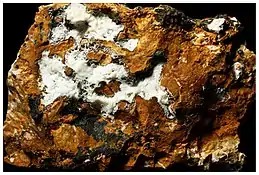Sauconite
Sauconite is a complex phyllosilicate mineral of the smectite clay group, formula Na0.3Zn3(SiAl)4O10(OH)2·4H2O. It forms soft earthy bluish white to red-brown monoclinic crystals typically massive to micaceous in habit. It has a Mohs hardness of 1 to 2 and a specific gravity of 2.45. Optically it is biaxial positive with refractive index values of nα = 1.550 - 1.580, nβ = 1.590 - 1.620 and nγ = 1.590 - 1.620.[2][4] It is found in vugs and seams in the oxidized zones of zinc and copper deposits. It occurs in association with hemimorphite, smithsonite, chrysocolla, coronadite and various iron oxides.
| Sauconite | |
|---|---|
 Sauconite (reddish brown) | |
| General | |
| Category | Phyllosilicate mineral |
| Formula (repeating unit) | Na0.3Zn3(SiAl)4O10(OH)2·4H2O |
| IMA symbol | Sau[1] |
| Strunz classification | 9.EC.45 |
| Crystal system | Monoclinic |
| Crystal class | Prismatic (2/m) (same H-M symbol) |
| Space group | C2/m |
| Identification | |
| Color | Reddish brown, brown, brownish yellow, mottled |
| Crystal habit | Clayey; as small micaceous plates in laminated to compact masses |
| Cleavage | Perfect on {001} |
| Mohs scale hardness | 1 - 2 |
| Luster | dull |
| Diaphaneity | Translucent |
| Specific gravity | 2.45 |
| Optical properties | Biaxial (-) |
| Refractive index | nα = 1.550 - 1.580 nβ = 1.590 - 1.620 nγ = 1.590 - 1.620 |
| Birefringence | δ = 0.040 |
| Dispersion | r > v strong |
| References | [2][3][4] |
It was named for the Saucon Valley in Pennsylvania, where it was originally discovered in 1875.[3]
References
- Warr, L.N. (2021). "IMA–CNMNC approved mineral symbols". Mineralogical Magazine. 85 (3): 291–320. Bibcode:2021MinM...85..291W. doi:10.1180/mgm.2021.43. S2CID 235729616.
- Mindat
- Webmineral data
- Handbook of Mineralogy
This article is issued from Wikipedia. The text is licensed under Creative Commons - Attribution - Sharealike. Additional terms may apply for the media files.